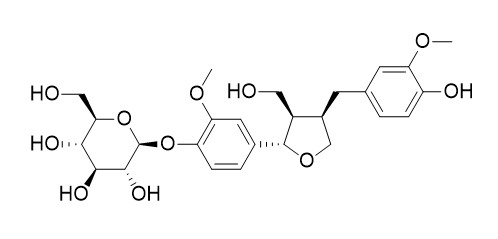Lariciresinol 4-O-glucosideCAS# 143663-00-7 |

Quality Control & MSDS
Package In Stock
Number of papers citing our products

| Cas No. | 143663-00-7 | SDF | Download SDF |
| PubChem ID | N/A | Appearance | Powder |
| Formula | C26H34O11 | M.Wt | 522.6 |
| Type of Compound | Lignans | Storage | Desiccate at -20°C |
| Solubility | Soluble in Chloroform,Dichloromethane,Ethyl Acetate,DMSO,Acetone,etc. | ||
| General tips | For obtaining a higher solubility , please warm the tube at 37 ℃ and shake it in the ultrasonic bath for a while.Stock solution can be stored below -20℃ for several months. We recommend that you prepare and use the solution on the same day. However, if the test schedule requires, the stock solutions can be prepared in advance, and the stock solution must be sealed and stored below -20℃. In general, the stock solution can be kept for several months. Before use, we recommend that you leave the vial at room temperature for at least an hour before opening it. |
||
| About Packaging | 1. The packaging of the product may be reversed during transportation, cause the high purity compounds to adhere to the neck or cap of the vial.Take the vail out of its packaging and shake gently until the compounds fall to the bottom of the vial. 2. For liquid products, please centrifuge at 500xg to gather the liquid to the bottom of the vial. 3. Try to avoid loss or contamination during the experiment. |
||
| Shipping Condition | Packaging according to customer requirements(5mg, 10mg, 20mg and more). Ship via FedEx, DHL, UPS, EMS or other couriers with RT, or blue ice upon request. | ||

Lariciresinol 4-O-glucoside Dilution Calculator

Lariciresinol 4-O-glucoside Molarity Calculator
| 1 mg | 5 mg | 10 mg | 20 mg | 25 mg | |
| 1 mM | 1.9135 mL | 9.5675 mL | 19.1351 mL | 38.2702 mL | 47.8377 mL |
| 5 mM | 0.3827 mL | 1.9135 mL | 3.827 mL | 7.654 mL | 9.5675 mL |
| 10 mM | 0.1914 mL | 0.9568 mL | 1.9135 mL | 3.827 mL | 4.7838 mL |
| 50 mM | 0.0383 mL | 0.1914 mL | 0.3827 mL | 0.7654 mL | 0.9568 mL |
| 100 mM | 0.0191 mL | 0.0957 mL | 0.1914 mL | 0.3827 mL | 0.4784 mL |
| * Note: If you are in the process of experiment, it's necessary to make the dilution ratios of the samples. The dilution data above is only for reference. Normally, it's can get a better solubility within lower of Concentrations. | |||||

Calcutta University

University of Minnesota

University of Maryland School of Medicine

University of Illinois at Chicago

The Ohio State University

University of Zurich

Harvard University

Colorado State University

Auburn University

Yale University

Worcester Polytechnic Institute

Washington State University

Stanford University

University of Leipzig

Universidade da Beira Interior

The Institute of Cancer Research

Heidelberg University

University of Amsterdam

University of Auckland

TsingHua University

The University of Michigan

Miami University

DRURY University

Jilin University

Fudan University

Wuhan University

Sun Yat-sen University

Universite de Paris

Deemed University

Auckland University

The University of Tokyo

Korea University
- 3'-O-Methylviolanone
Catalog No.:BCN0739
CAS No.:56973-42-3
- Methyl 2-hydroxy-3,4-dimethoxybenzoate
Catalog No.:BCN0738
CAS No.:6395-23-9
- Methylpicraquassioside B
Catalog No.:BCN0737
CAS No.:1443757-89-8
- Yinxiancaoside C
Catalog No.:BCN0736
CAS No.:1159908-74-3
- 3-O-Methylellagic acid 3'-O-alpha-rhamnopyranoside
Catalog No.:BCN0735
CAS No.:352280-34-3
- Bocconoline
Catalog No.:BCN0734
CAS No.:32906-88-0
- Isosilychristin
Catalog No.:BCN0733
CAS No.:77182-66-2
- Hydroxytyrosol 1-O-glucoside
Catalog No.:BCN0732
CAS No.:76873-99-9
- Wallicoside
Catalog No.:BCN0731
CAS No.:88797-59-5
- Securisteroside
Catalog No.:BCN0730
CAS No.:54964-57-7
- Byzantionoside B
Catalog No.:BCN0729
CAS No.:189109-45-3
- Grasshopper ketone
Catalog No.:BCN0728
CAS No.:41703-38-2
- 10-O-trans-p-coumaroylscandoside
Catalog No.:BCN0741
CAS No.:870785-25-4
- Cuneataside C
Catalog No.:BCN0742
CAS No.:871720-16-0
- 5,6,7,3',4',5'-Hexamethoxyflavanone
Catalog No.:BCN0743
CAS No.:74064-17-8
- Theaflavanoside II
Catalog No.:BCN0744
CAS No.:943785-09-9
- 3',8-Dihydroxyvestitol
Catalog No.:BCN0745
CAS No.:122587-87-5
- Sativanone
Catalog No.:BCN0746
CAS No.:70561-31-8
- 10-O-trans-p-Feruloylscandoside
Catalog No.:BCN0747
CAS No.:1428268-72-7
- 2,3-Dehydrosilychristin
Catalog No.:BCN0748
CAS No.:57499-41-9
- Picraquassioside B
Catalog No.:BCN0749
CAS No.:169312-05-4
- Mucronulatol
Catalog No.:BCN0750
CAS No.:20878-98-2
- Tortoside B (Manglieside E)
Catalog No.:BCN0751
CAS No.:190655-17-5
- Caffeic acid 4-O-glucuronide
Catalog No.:BCN0752
CAS No.:1093679-71-0
Isolation and characterization of novel benzoates, cinnamates, flavonoids, and lignans from Riesling wine and screening for antioxidant activity.[Pubmed:11409967]
J Agric Food Chem. 2001 Jun;49(6):2788-98.
A German Riesling wine has been fractionated with the aid of countercurrent chromatography. After purification by HPLC, the structures of 101 compounds were established by mass spectrometry and NMR spectroscopy. Seventy-three of the isolated compounds exhibited a phenolic or benzylic structure. Fifty-four compounds were reported for the first time as Riesling wine constituents. New compounds identified in this work included twelve benzoic and cinnamic acid derivatives. In addition to two isomeric (E)-caffeoyl ethyl tartrates, the glucose esters of (E)-cinnamic, (E)-p-coumaric, and (E)-ferulic acid, as well as the 4-O-glucosides of (E)- and (Z)-ferulic acid, have been identified for the first time in Riesling wine. The structures of two additional phenylpropanoids were elucidated as 3-hydroxy-1-(4-hydroxy-3-methoxyphenyl)-propan-1-one and 2,3-dihydroxy-1-(4-hydroxy-3-methoxyphenyl)-propan-1-one. Moreover, two ethyl esters, i.e., ethyl protocatechuate and ethyl gallate, as well as the glucose ester of vanillic acid, were newly detected in Riesling wine. Novel representatives in the flavonoid group were dihydrokaempferol, dihydroquercetin, and four dihydroflavonol glycoconjugates, i.e., the 3-O-glucosides of dihydrokaempferol and dihydroquercetin, as well as the 3-O-xyloside and the 3'-O-glucoside of dihydroquercetin. Additionally, six novel lignans, i.e., Lariciresinol 4-O-glucoside, three isolariciresinol derivatives, and two secoisolariciresinols, as well as three neolignans were isolated. Structural elucidation of the newly isolated wine constituents is reported together with the determination of their antioxidant activity.


